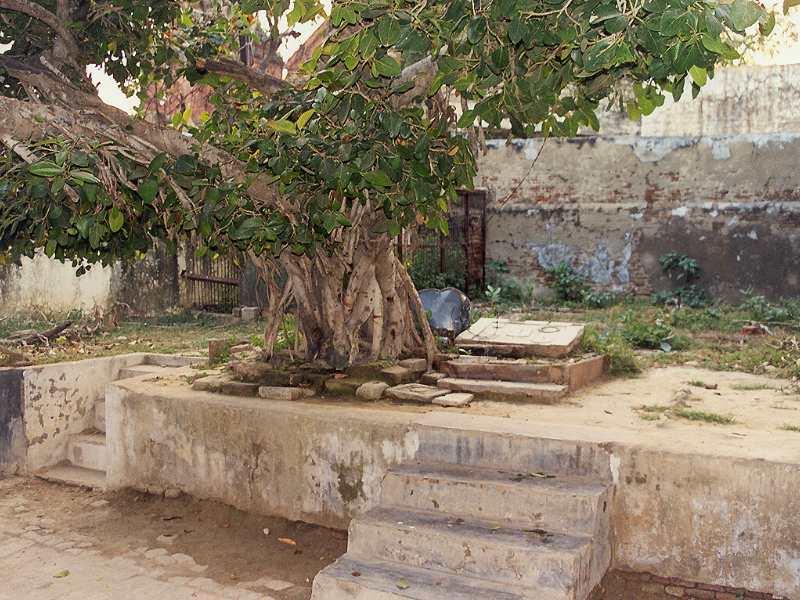
Advaita Vata
0 likes
Vraj Mandal Parikarma – by Rajshekhar Das Brahmacari
This is one of Vrindavana’s famous banyana trees (vata-vriksa) and the place where Advaita Acharya performed his bhajana during the period of his stay in Vrindavana. While staying in Vrindavana, It is said Advaita Acharya had the great opportunity to meet Shrila Madhavendra Purl Goswarni who was at the time on pilgrimage to Vraja, and took initiation from him here in Vrindavana in the year 1482. Beneath this same banyana tree, Advaita Acharya discovered the famous deity ofMadana-mohana, also called Madana-gopala that had been originally established by Vajranabha Maharaja five thousand years earlier, but in the course of history had been lost. According to some, the deity discovered by Advaita Acharya was called Madanagopala, and was a different deity to Madana-mohana, but this is not accepted by research scholars, who have concluded that Madana-gopala was another name of Madana-mohana which was used by Advaita Acharya and many others. Krishna’s great grandson Vajranabha had at least sixteen deities carved including, four devas, two nathas, and two gopalas (cowherd boys). The two gopalas were named Sakshi-gopala and Madana-mohana, also called Madana-gopala. This celebrated spot beneath the banyan tree at Advaita Vata is accepted by all scholars as the actual appearance place of Lord Madana-mohana. Unfortunately, due to insufficient historical records, there will always be opposing opinions regarding the detailed history, not only of this particular deity, but of many others as well.
When Advaita Acharya left Vrindavana for Navadwipa, it is said that the deity of Lord
Madana-mohana informedAdvaita Acharya in a dream that He was unwilling to leave Vrindavana, and therefore Advaita Acharya kept the deity with a Mathura brahmana named Chou be. According to the Seva Prakatya, Chou be lived at Mahavana where the deity was supposedly being worshiped. This deity of Madana-gopala was later handed over to Sanatana Goswami, because the deity desired to worshiped by Sanatana and be brought back to Vrindavana. Sanatana Goswami initially kept the deity in the crevasse of a tree and renamed the deity as Madana-mohana, after some period of time a temple was built on top of Dwadashaditya Tila. It is said that when Advaita Acharya returned to Bengal, he began worshiping a small deity of Krishna that he also named Madana-gopala, and this is one of the reasons why the confusion has arisen. Recently, this small deity of Madana-gopala was brought to Vrindavana from Bengal amid claims that it was the deity found at Advaita Vata, but this idea has been rejected by Gaudiya scholars. The fact is that all the deities carved by Vajranabha are quite large and distinct, and besides this, there are no historical records that Lord Madana-mohana (Madana-gopala) left Vrindavana before 1670, prior to Aurangzeb’s attack on the holy city. Another important point is that the Bhakti-ratnakara says that Lord Chaitanya as well as Lord Nityananda both had darshana of Madana-gopala at Mahavana some years after Advaita Acharya had returned to Bengal. Madana-mohana was accepted
to be Vajranabha’s original deity by the Six Goswamis and all other Gaudiya Vaishnavas authorities since the time of Lord Chaitanya Mahaprabhu.
When Advaita Acharya left Vrindavana for Navadwipa, it is said that the deity of Lord
Madana-mohana informedAdvaita Acharya in a dream that He was unwilling to leave Vrindavana, and therefore Advaita Acharya kept the deity with a Mathura brahmana named Chou be. According to the Seva Prakatya, Chou be lived at Mahavana where the deity was supposedly being worshiped. This deity of Madana-gopala was later handed over to Sanatana Goswami, because the deity desired to worshiped by Sanatana and be brought back to Vrindavana. Sanatana Goswami initially kept the deity in the crevasse of a tree and renamed the deity as Madana-mohana, after some period of time a temple was built on top of Dwadashaditya Tila. It is said that when Advaita Acharya returned to Bengal, he began worshiping a small deity of Krishna that he also named Madana-gopala, and this is one of the reasons why the confusion has arisen. Recently, this small deity of Madana-gopala was brought to Vrindavana from Bengal amid claims that it was the deity found at Advaita Vata, but this idea has been rejected by Gaudiya scholars. The fact is that all the deities carved by Vajranabha are quite large and distinct, and besides this, there are no historical records that Lord Madana-mohana (Madana-gopala) left Vrindavana before 1670, prior to Aurangzeb’s attack on the holy city. Another important point is that the Bhakti-ratnakara says that Lord Chaitanya as well as Lord Nityananda both had darshana of Madana-gopala at Mahavana some years after Advaita Acharya had returned to Bengal. Madana-mohana was accepted
to be Vajranabha’s original deity by the Six Goswamis and all other Gaudiya Vaishnavas authorities since the time of Lord Chaitanya Mahaprabhu.
Shri Vraj Mandal Parikarma
Advaitavaöa is situated directly in Praskandana-tértha. Just before the advent of Çré Caitanya Mahäprabhu, Çré Advaita Äcärya came to this place while journeying through Vraja. He resided under this same banyan (vaöa) tree for several days. He had found Çré Madana-Gopäla in Mahävana-Gokula, and now served Him here. Due to fear of the Yavanas, and by His desire, He secretly left Çré Madana-Gopäla with a devoted Caube brähmaëa and went to Çäntipura, knowing that very soon Çacénandana Çré Gaurahari would appear in the town of Nadiyä. Later, that same Madana-Gopäla made His way to Sanätana Gosvämé, who had a large temple constructed just nearby and established the deity there. Since then, Çré Madana-Gopäla became known as Çré Madana-mohana
Leave a comment